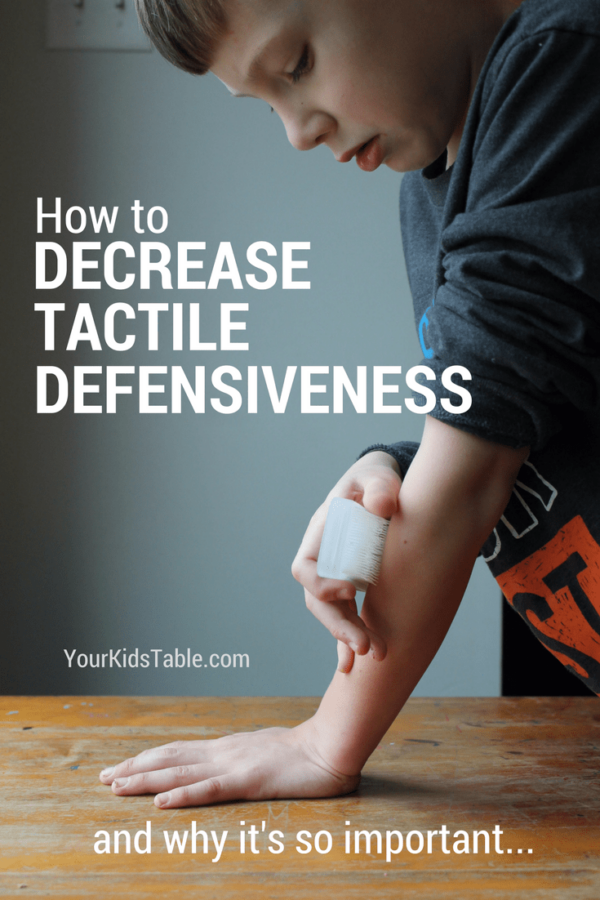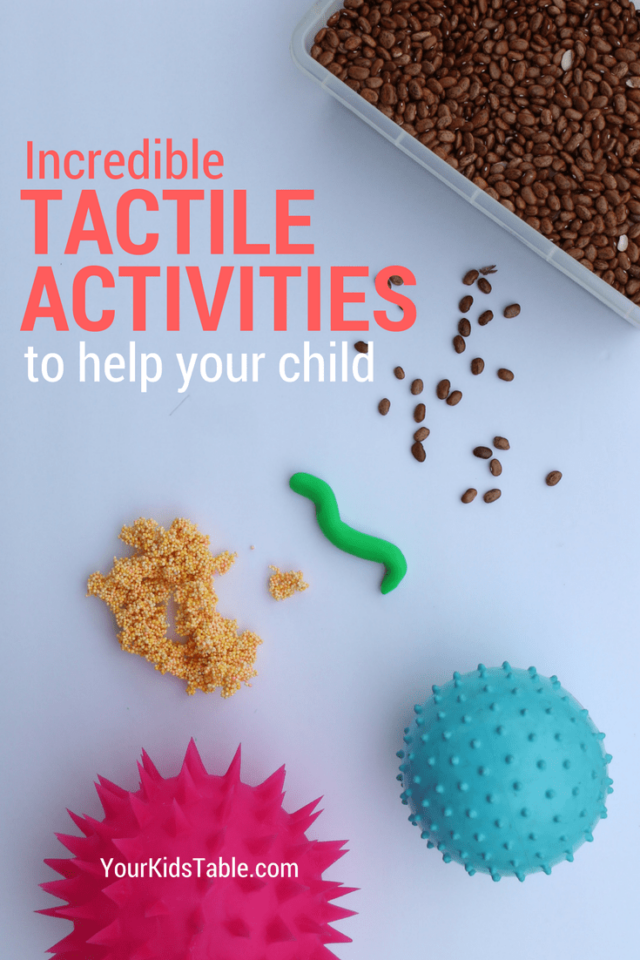Everything you need to know about the tactile sense from tactile defensiveness, tactile seeking behaviors, tactile play ideas, and the best tactile toys! Plus, the big connection between the tactile system and picky eating.
Our tactile sense is truly amazing and affects our daily lives in ways that many times we aren’t even aware of. Just the other day, as were beginning to round the end of August, I finally crossed one of the last remaining items off the summer bucket list: letting the kids play outside in shaving cream. This activity reminded me of just how incredible our tactile system is.
As I was squeezing the nozzle on the can into our well-used and sun-worn water table, I was thinking about how differently each of my kids would respond to this interesting and messy texture. It had been quite a while since they had played in it, a year in fact. I started making giant foam mountains all over the table and my two older children squealed and jumped around in delightful anticipation.
My youngest, nearly 3, was quite motivated by his brother’s infectious cheers and joined in, but between his happy shouts out of the corner of my eye I saw him gagging and drooling all over the place.
What?
Why?
To be honest, I wasn’t completely surprised. My youngest child has developed a kind of tactile defensiveness when it comes to messy textures. I was fully prepared for him to refuse the activity (although I had some tricks up my sleeve to get him engaged), but gagging is pretty intense. And that gagging, just from looking at a texture, tells me that his tactile sense is very sensitive to shaving cream.
What is the Tactile Sense?
Our tactile sense is one of the 5 classic senses that we’ve all learned about and it allows us to experience and literally feel different kinds of textures or touches. Our tactile sense runs over every square inch of skin we have and sends messages to our brain nearly constantly about what we are feeling. There are higher concentrations of receptors in our hands, feet, and mouth.
Is it hot or cold?
Is it painful?
Is it soft, rough, silky, slimy, etc.?
Our tactile system gives us all this information, and that’s pretty important because it allows us to understand and explore our environment. When the tactile sense is working well, we hardly notice that it’s at work at all.
When it isn’t working well, sometimes we don’t like the way certain textures feel, so much so that we gag before we even touch them because the thought of touching them sends shivers down our spine like nails on a chalkboard. This is exactly what happened to my youngest son, James. His tactile sense was in overdrive and his brain responded in kind.
The Truth About Tactile Defensiveness
Tactile defensiveness is a big word that basically means you’re sensitive to the way certain textures feel. We notice this defensiveness most commonly with kids who refuse to use finger paints, gag and even throw up when touching different foods, or melting down if they must walk barefoot in the sand or grass.
Some other examples of tactile defensiveness are:
- Walking on toes (although there are other reasons for this too)
- Strongly preferring certain types of clothing and disliking other’s (learn more about how to help sensory issues with clothing here)
- Disliking lotion
- Seams inside socks and tags in clothing are extremely irritating
- Only accepts certain textures of food (most often crunchy, but sometimes smooth or soft)
- May not like to hold hands
- Jumps at sudden or light touches
Depending on how many of these examples a child actually displays really determines how big of an issue it is. As in some instances, tactile defensiveness can really begin to make normal life hard for some kids and parents.
Sometimes tactile defensiveness can go away on its own, and often times it can be improved, quite dramatically, in a way that doesn’t cause any stress to a child by slowly exploring and playing with different textures. In general, some textures are easier to tolerate than other’s and that’s a great starting place (more on what they are in a minute).
Also, a popular program called The Wilbarger Brushing Protocol has also been shown to be very effective in helping diminish or nearly eliminate tactile defensiveness. This technique must be taught by someone certified to do so, however. That person is typically an OT. You can find out how and if your child would benefit from more sensory help in Sensory Integration Therapy. (This brush is seen in the picture above)
It’s extremely important to respect and NEVER force kids with tactile defensiveness to touch something they don’t want to. They know their body best and what it can handle. While it can be absolutely frustrating, the sensation they are experiencing is likely quite different than how you experience it. What seems “just a little messy” to you, can actually be perceived as painful to a child that’s tactile sense is sensitive.
Slow and steady is the best approach when using tactile activities to improve tactile defensiveness. (You’ll find these ideas below)
But, Some Kids Are Tactile Seeking!
As with every one of our 7 senses (yes, you heard me right there are 7, learn more in What is Sensory), kids and adults alike can either avoid certain sensations, as with tactile defensiveness, or seek them out. While my youngest child was gagging at the thought of touching the shaving cream, my oldest two literally started to cover themselves in it, as you can see in the pictures.
They actually stripped down to their underwear so they could rub it all over their arms, legs, and chest… laughing the entire time.
This was completely unprompted by me, but the same thing happens every time we get it out, and not because it’s habit. It’s very obvious that my older two kids love and enjoy most types of tactile input. But my middle son, who admittedly has more sensory needs, has some tactile seeking behaviors.
While leaving Karate we passed a bunch of high weeds growing in between cracks in the asphalt. Some of the weeds had those big fuzzy tops on them. When he walked by, he bent down and rubbed his face on all of them… with a huge smile on his face. Kids that are tactile seekers will often touch everything and have a hard time keeping their hands to themselves.
Some more examples of tactile seeking are:
- Constantly touching racks of clothing when walking by
- Loving lotions and massages
- Rubbing face on different textures, usually common objects like throw pillows or the dog!
- Plays with their food, a lot
- Rubs paint on hands or paints body during painting activities
- Enjoys cuddling, holding hands
- Has a favorite stuffed animal or blanket that they rub
Giving kids that are tactile seeking a chance to touch and explore different textures can help cut down on the sometimes inappropriate ways they try to get their tactile sense needs met. It can also be helpful to teach them about what is okay to touch and what is not. For some kids with really a strong need to have tactile input, it may be helpful to carry some special objects and items with you (see below).
To learn more about how and why it’s important to meet your child’s sensory needs head to: What is a Sensory Diet.
I should note that some kids can actually be tactile seeking and tactile defensive, depending on the texture. This is the case for my middle son, Isaac. As you already heard, he painted himself in shaving cream, but he’s not too fond of jello and some other slimy textures. In fact, he used to detest it, because of the tactile activities his sensory processing has improved, but it’s very common to have a mix of both.
(Get inspired with 47 more messy play activities that will give lots of tactile input!)
Tactile Play for All
The really important point is that tactile play and stimulating the tactile system is really important for any child’s development, but it also helps both kids with tactile defensiveness and tactile seeking behaviors! Get a free printable to plan activities in Sensory Diet Template.
Thinking about tactile play in the simplest way, it’s all about getting kids to touch different textures which happens in many daily activities like cooking, arts and crafts, and outdoor play.
Some really specific ideas are:
- Carving a pumpkin or melon together and scooping out the seeds
- Paper mache project
- Making a home-made slime recipe
- Kneading fresh dough
- Making mud pies in the back yard
- Using pipcleaners, playdough, or glitter to make shapes and letters that can be traced with a fingertip (an excellent learning activity too!)
- Building sand castles
- Stomp on bubble wrap with paint (check out how to set it up here)
One of my favorite ways to invite this tactile play is to set up a sensory bin, which is basically a large container that you fill with a texture. When I put shaving cream in our water table, I created a sensory bin. A sandbox is also a sensory bin. Get an entire guide for setting up, playing with, and texture ideas for sensory bins.
I love to gather and put in dry textures like birdseed and rice for play too, as the gritty nature of both of these really give a ton of input to the tactile sense. These two textures in particular, in addition to sand, are where I start with a kids that have tactile defensiveness.
If a child won’t play in sand, then they likely aren’t going to come near finger paint with a ten foot pole, and again, the gritty texture does help to desensitize as well. But, if these textures seem like too big of a leap, dry beans or noodles are even easier. For kids that are tactile seeking, I like to provide a variety of textures on a regular basis that also include:
- cornmeal
- flour
- cloud dough
- play dough
- finger paints (home-made works too)
- shaving cream/whipped cream
However, it can be helpful to occasionally give even a child with tactile defensiveness a really challenging texture to play in as well. The key to making that successful is to either have some excellent peers to copy, as was the case the with my gagging at the sight of shaving cream son, or to give them some tools, like shovels and spoons to use in the texture.
I also like to take toys and puzzle pieces and hide them in the texture or sensory bin. All of this can be extremely motivating, but you may have to demonstrate, encourage, and entice.
Even though James was gagging just looking at the shaving cream, he ended up touching it, rubbing it on his hands, rubbing it on his feet, and tolerating some on his belly and legs. Some matchbox cars helped him to initially touch the shaving cream, and then I showed him how to draw in it with his finger. From there it continued to snowball until he was running around and enjoying the fun with his brother’s.
For him, this tactile activity was a huge success and because of it, his sensory processing improved. That literally means that his brain was experiencing the shaving cream in a new positive way!
Of course, there were times I noticed he was tentative, and I was careful to watch for his reaction. And, there were times that he asked to have his hands washed off (we had a hose nearby). I reassuringly did so, because I wanted him to know he could trust me to help him if it got uncomfortable.
Whenever using tactile activities with a child that is tactile defensive, have some wet and dry towels nearby. Show them where they are so they can help themselves as well. Also, don’t just focus on their hands, once they are comfortable, encourage exploration with feet too! Sensory bins and sandboxes are perfect for this!
If you’re looking for more sensory activities check out proprioceptive activities and vestibular activities. The proprioceptive, vestibular, and tactile systems are the power houses of the sensory system!
The Best Tactile Toys (In my opinion!)
Affiliate links used below. See our full disclosure.
You already know that I love sensory bins and using regular cooking and arts and crafts to give kids a chance to stimulate the tactile sense, but if you want a few other ideas to have in the toy bin or in a sensory bag for the car/school, these are my occupational therapist approved go-to items:
- Fidget Toys to squeeze and feel
- Tag blanket
- Putty to pull, roll, and stretch
- Tactile bean bags (all have different textures)
- Large Spikey balls
- Dry Play Foam (seen in the picture above)
The Connection Between the Tactile Sense and Picky Eating
Lastly, I’d be totally remiss if I didn’t talk about the huge connection between the tactile sense and picky eating.
Kids that have tactile defensiveness with at least a few textures are very likely to also be picky eaters, and the more severe tactile defensiveness is for a child, the more the severe picky eating will often be. These two go hand in hand, but not all picky eaters have a tactile sensitivity.
The reason the tactile sense is so heavily tied to picky eating is because we often decide what we like to eat or don’t based on the texture of a food. Think about a food you really don’t like right now, I bet at least a component of the reason why is because you don’t like how it feels. If a child won’t touch a food, they surely won’t taste it, that’s way more of an intense experience that simply touching it, not to mention that several other senses all enter the mix once it enters the mouth.
Working on improving tactile defensiveness through sensory bins and other tactile play will have a direct and very positive effect on picky eating.
Learn more strategies for sensory aversions to food.
Want to Learn More about How to Help Your Sensory Kid?
If you’d like to learn even more about how to meet your child’s sensory needs, across all of the senses then come join me as I teach an exciting and inspiring free workshop: 3 Expert Secrets to Calm and Focus Your Child with Specialized Sensory Activities. In the workshop, I’ll uncover these secrets that can make like feel easier and less frustrating, as your child is finally able to calm down, focus, and much more.
More on the Tactile Sense
Everything Oral Sensory: The Total Guide
How to Choose the Right Sensory Toy for Your Child
13 Easy Sensory Strategies for the Classroom
10 Sensory Red Flags You Might Be Missing
Did You Pin This?
Hover over or click any image for the “pin it” button to appear!
Alisha Grogan is a licensed occupational therapist and founder of Your Kid’s Table. She has over 14 years experience with expertise in sensory processing and feeding development in babies, toddlers, and children. Alisha also has 3 boys of her own at home. Learn more about her here.




HI My 8 yo son is the exact opposite! He is tactile seeking and has tactile hyposensitivity. He has ADHD (not ASD). He doesnt feel when his face is dirty or if the water is too hot or cold. He also cannot tell if he is full and is constantly eating to feel the food in his mouth. This has led to a lot of weight gain. Would you have advice or resources for that?
Hi Eli,
It sounds like your child either has low registration of sensory input or difficulties with their interoceptive sense– both can be improved! Sensory processing is somewhat of a spectrum from high “Seeking” to low “avoidance” and then low registration as I mentioned. Read through these posts and they can shed some light!
Best,
Laura
Your Kid’s Table OT
I just ran into this article and it was like reading my childhood. Now as an adult, I’m having a sudden aversion to bras and intense “cravings” for hugging everyone. I’ve adjusted but sometimes it wears me down and I lose weight because I don’t want any foods. I’m so glad to read this because I’m sure it will help parents out there! Like the above comment, I too am curious how we can reduce this in adulthood?
Thanks so much for sharing with us! As adults we typically find ways to make ourselves comfortable with our sensory needs like changing the types of clothing we wear, chewing gum, listening to a noise for sleeping, etc. If you do feel you need “more” intervention. It will be some of the same types of tactile desensitization such as the brushing. However, seeking out someone who works in the adult world would be helpful!
Best,
Desiree
Hi, I am 50 years old and only now decided to look up a strange habit I have had since childhood. I rub a piece of satin between my thumb and index finger. I have always assumed it was a compulsive behavior that caused no harm. I found multiple forums where the entire topic is this exact habit. I am an extremely picky eater, and I display both tactile defensive and seeking. I am curious if this can hamper an adult life or have a connection to any problematic issues. I’ve adapted in life to avoid feeling the sensations I hate. I also must have a clean environment or I just feel gross and covered in dirt or something. I didn’t expect to share this habit with so many other adults and kids. Could you point me to any adult info? Thank you